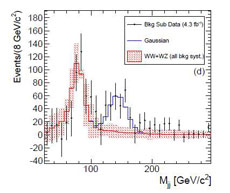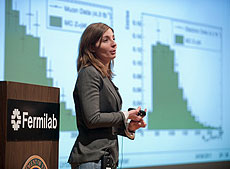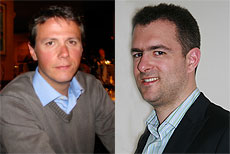|
Have a safe day!
Thursday, April 7
1 p.m.
Special Physics Seminar - One West
Speaker: Daniel M. Kaplan, Illinois Institute of Technology
Title: New Experiments with Antiprotons
2:30 p.m.
Theoretical Physics Seminar - Curia II
Speaker: Joel Giedt, Rensselaer Polytechnic Institute
Title: Dark Matter, the CMSSM and Lattice QCD
3:30 p.m.
DIRECTOR'S COFFEE BREAK - 2nd Flr X-Over
4 p.m.
Accelerator Physics and Technology Seminar - One West
Speaker: Zhijun Chen, Argonne National Laboratory
Title: Materials Science Challenges for YBCO-Based High Temperature Superconducting Magnets
Friday, April 8
3:30 p.m.
DIRECTOR'S COFFEE BREAK - 2nd Flr X-Over
4 p.m.
Joint Experimental-Theoretical Physics Seminar - One West
Speakers: Mark Neubauer, University of Illinois, Urbana/Champaign
Title: New Results from ATLAS
Click here for NALCAL,
a weekly calendar with links to additional information.
Upcoming conferences
|
|
Thursday, April 7
- Breakfast: Apple sticks
- Southwestern chicken tortilla
- Philly-style cheese steak
- *Garlic-herb roasted pork
- Mardi gras jambalaya
- *Southwestern turkey wrap
- Assorted sliced pizza
- *Marinated grilled chicken Caesar salads
*Carb restricted alternative
Wilson Hall Cafe Menu
|
|
Friday, April 8
Dinner
Guest Chef: Jean Reising
- Mixed greens, red onion and cherry tomatoes with balsamic vinaigrette
- Steamed lobster tail with a tomato-thyme butter sauce
- Spring pea risotto
- Grilled asparagus
- Bittersweet chocoalte pots de crème with fresh berries
Wednesday, April 13
Lunch
- Chili chicken skewers wtih cilantro pesto
- Chunky banana sweet potato mash
- Key lime tequila pie
Chez Leon Menu
Call x3524 to make your reservation.
|
|
Wait! Don’t open that e-mail yet
 |
| Read your e-mail carefully to avoid falling prey to phishing attempts. |
You should second guess all e-mails from companies right now because of a trend in very targeted phishing attempts.
The news media reported earlier this week that Epsilon, an e-mail marketing company, experienced a large data loss to hackers. Epsilon lost e-mail addresses it stores for companies. Those companies are reported to include TiVo, Chase, Walgreens, TIAA-CREF, Best Buy and many others. I received a message from 1800flowers.com apologizing because my e-mail was among those lost by Epsilon.
This loss is particularly dangerous because it includes not just your e-mail address, but also the names of companies you have done business with. If your e-mail address is among those that were lost, you may receive phishing e-mails that look just like e-mail messages a company would send you. For example, you might receive an e-mail claiming to include coupons from Walgreens, or claiming that your bank account needs to be updated or that your quarterly retirement account statement is ready for viewing. Those messages will be crafted to look like messages you’ve received from those companies in the past.
Those e-mails may come to your personal e-mail address or to your FNAL e-mail address if you’ve used that address for any communications with companies involved in this loss. So it’s important for you to be especially careful responding to e-mails or following links in e-mails or opening attachments in e-mails that appear to come from companies you’ve done business with and might be expecting messages from.
Read more |
TIAA-CREF e-mail addresses accessed
TIAA-CREF, the retirement account vendor used by Fermilab, recently informed the laboratory that files containing the first names, last names and e-mail addresses of some TIAA-CREF participants were accessed without authorization. TIAA-CREF uses Epsilon, the e-mail database company mentioned above, to send e-mails to its clients. Please note that TIAA-CREF customer account or financial information was NOT shared with Epsilon. Customer account information remains intact and secure.
Because of this, there is a chance you may receive unsolicited (spam) e-mails. As always, do not reply to e-mails asking for your personal information, account numbers or any other type of confidential information. TIAA-CREF will never ask for your personal information or login credentials in an e-mail.
|
Monday evening
 |
| Alex Naumov, TD, took this photo at the laboratory on his way to DZero on April 4. |
|
Tevatron claims possible glimpse of particles beyond the standard model
From Nature, April 6, 2011
Just as the Tevatron, the proton-antiproton collider at Fermilab in Batavia, Illinois, enters its final months of operations, possible signals of new physics are emerging. First came a report from the Collider Detector at Fermilab (CDF) experiment of a puzzling asymmetry in the way top quarks decay into lighter particles. Now the same experiment is reporting on the possible observation of particles beyond the standard model in collisions that produce a W boson – a particle of the weak nuclear force. Spokesmen for the experiment say the signal may be due to random fluctuations, but that it’s nonetheless causing some excitement. “Either what we thought we knew about this process is wrong or there’s a totally new effect,” says Giovanni Punzi, CDF co-spokesman.
CDF looked at events caused by the collisions of protons and antiprotons forming a W together with two jets of particles, carrying away energy. At a collision energy of around 144 GeV they saw an excess of electrons and muons – around 253 more than expected against a background of around 10,000, Punzi says. The excess could be caused by the creation of a new particle that decays into an extra W (that in turn decays into electrons or muons) and another lighter particle that produces jets. The effect has a magnitude of 3.2 standard deviations, enough to be considered intriguing, but not enough to claim a discovery.
Read more
|
US atom smasher may have found new force of nature
From Jakarta Globe, April 7, 2011
Data from a major US atom smasher lab may have revealed a new elementary particle, or potentially a new force of nature, one of the physicists involved in the discovery told AFP on Wednesday.
The physics world was abuzz with excitement over the findings, which could offer clues to the persistent riddle of mass and how objects obtain it -- one of the most sought-after answers in all of physics.
But experts cautioned that more analysis was needed over the next several months to uncover the true nature of the discovery, which comes as part of an ongoing experiment with proton and antiproton collisions to understand the workings of the universe.
"There could be some new force beyond the force that we know," said Giovanni Punzi, a physicist with the international research team that is analyzing the data from the US Department of Energy's Fermi National Accelerator Laboratory.
Read more
|
|
The data peak that causes excitement
 |
|
The di-jet invariant mass distribution for candidate events selected in an analysis of W+2 jet events. The black points represent the data. The red line plots the expected Standard Model background shape based on Monte Carlo modeling. The red shading shows the systematic and statistical uncertainty on this background shape. The blue histogram is the Gaussian fit to the unexpected peak centered at 144 GeV/c2
|
Wednesday afternoon, the CDF collaboration announced that it has evidence of a peak in a specific sample of its data. The peak is an excess of particle collision events that produce a W boson accompanied by two hadronic jets. This peak showed up in a mass region where we did not expect one. The peak was observed in the 140 GeV/c2 mass range, as shown in the plot above. It is the kind of peak in a plot that, if confirmed, scientists associate with the existence of a particle. The significance of this excess was determined to be 3.2 sigma, after accounting for the effect of systematic uncertainties. This means that there is less than a 1 in 1375 chance that the effect is mimicked by a statistical fluctuation. Particle physicists consider a result at 5.0 sigma to be a discovery.
The excess might be explained by the production of a new, unknown particle that is not predicted by the Standard Model, the current standard theory of the fundamental laws of physics. The features of this excess exclude the possibility that this peak might be due to a Standard Model Higgs boson or a supersymmetric particle. Instead, we might see a completely new type of force or interaction. A few models proposed and developed in recent years postulate the existence of new fundamental interactions beyond those known today, which would create an excess similar to the one seen in the CDF data. That’s why everybody at CDF is excited about this result.
The alternative explanation for this excess would be that we need to reconsider the theory that is used to predict the background spectrum, which is based on standard particle physics processes. That possibility, albeit less glamorous, would still have important implications. Those calculations use theoretical tools that are generally regarded as reliable and well understood, and form the basis of many other predictions in particle physics. Questioning these tools would require us to challenge our understanding of the fundamental forces of nature, the foundation of particle physics.
The current analysis is based on 4.3 inverse femtobarns of data. The CDF collaboration will repeat the analysis with at least twice as much data to see whether the bump gets more or less pronounced. Other experiments, including DZero and the LHC experiments, will look for a particle of about 140 GeV/c2 in their data as well. Their results will either refute or confirm our result. Our result has been submitted to Physical Review Letters. You can read the paper and watch the lecture online.
It remains to be seen whether this measurement is an important indication of long-awaited new physics beyond the Standard Model.
-- Edited by Rob Roser and Giovanni Punzi
 |
|
CDF Collaborator Viviana Cavaliere, University of Illinois at Urbana-Champaign, presents the new CDF result in Ramsey Auditorium on Wednesday, April 6. Cavaliere is one of the collaborators responsible for this analysis.
|
 |
|
Pierluigi Catastini, Harvard University; and Alberto Annovi, INFN; are two of the analyzers responsible for this analysis.
|
View this article on a separate page
|
|